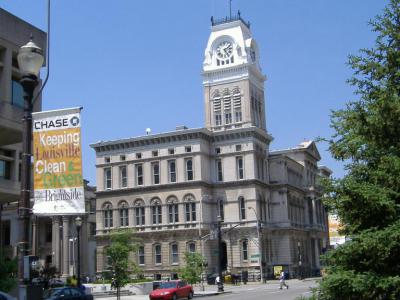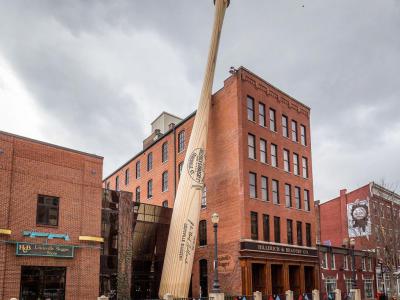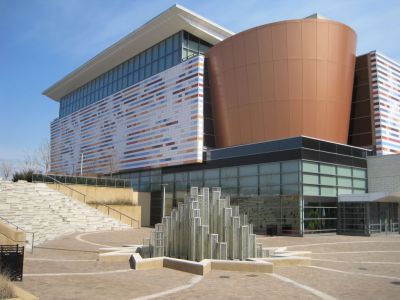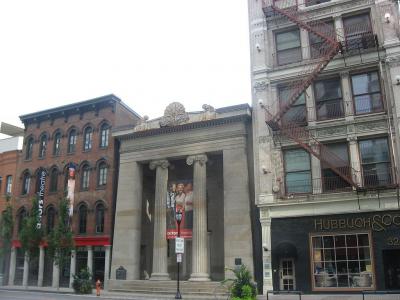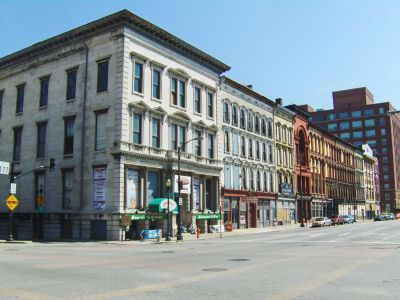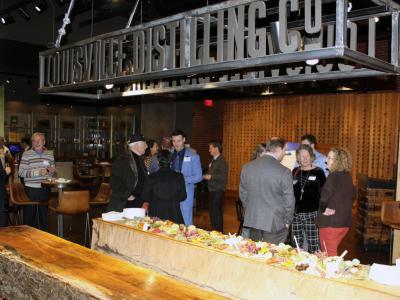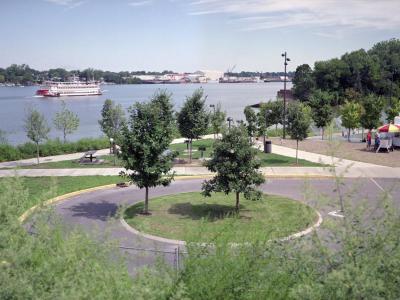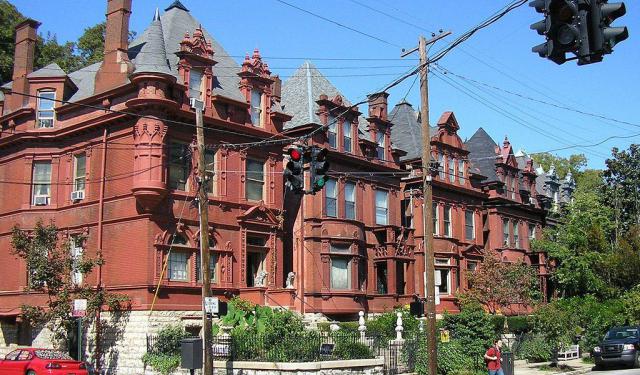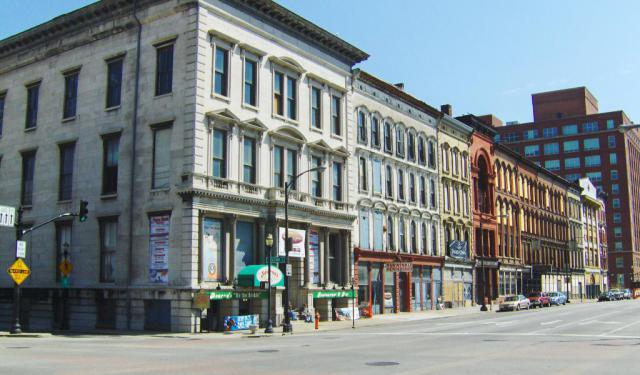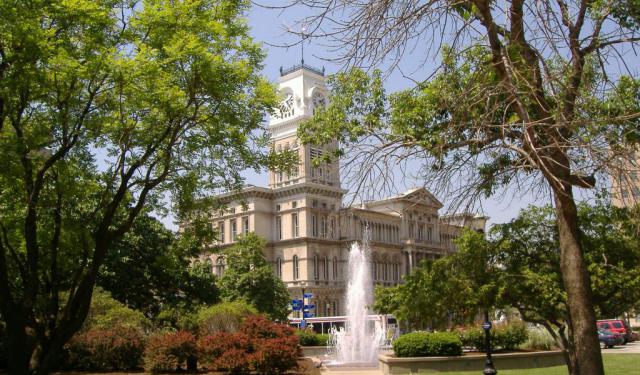
Louisville Introduction Walking Tour (Self Guided), Louisville
Poised on the banks of the Ohio River, Kentucky's largest city Louisville blends small-town charm with urban sophistication. The first European settlement in the vicinity of modern-day Louisville was on Corn Island, established in 1778 by Col. George Rogers Clark, credited as the founder of the city. Two years later, the Virginia General Assembly approved the town charter of Louisville. The city was named in honor of King Louis XVI of France, whose soldiers were then aiding Americans in the Revolutionary War.
Early Louisville was a major shipping port with slaves working in a variety of associated trades. The city was often a point of escape for slaves to the north. During the Civil War, Louisville was a major stronghold of Union forces, which kept Kentucky firmly in the Union.
In 1914, the City of Louisville passed a racially-based zoning residential zoning code, following Baltimore, Atlanta, and a handful of cities in the Carolinas. In 1929, it completed the lock and dam in the Falls of the Ohio and began referring to itself as "where Northern enterprise and Southern hospitality meet". Between the industrial boom of that year and through the Great Depression, Louisville gained 15,000 new residents, about three percent of them black.
Since the 1980s, many of the city's urban neighborhoods have been revitalized into areas popular with young professionals and college students. As of the late 1990s, Downtown has experienced significant residential, tourist and retail growth, including the addition of major sports complexes such as Louisville Slugger Field, conversion of waterfront industrial sites into Waterfront Park (an 85-acre outdoor space along the Ohio River), and openings of varied museums.
Science and architecture buffs will certainly take interest in the Thomas Edison House and the Old Bank of Louisville building, while those big on sports should consider visiting Louisville Slugger Museum & Factory (showcasing how the famous baseball bats are made), and the Muhammad Ali Center (celebrating the life of Louisville-born, world-famous boxer Muhammad Ali). And if you're keen on whiskey, you might as well be willing to check out Whiskey Row – apart from being the home to KFC, Louisville is known for bourbon that is long associated with Kentucky.
To acquaint yourself with these and other delights of Louisville, a treasure trove of themed attractions, take this self-guided introduction walk.
Early Louisville was a major shipping port with slaves working in a variety of associated trades. The city was often a point of escape for slaves to the north. During the Civil War, Louisville was a major stronghold of Union forces, which kept Kentucky firmly in the Union.
In 1914, the City of Louisville passed a racially-based zoning residential zoning code, following Baltimore, Atlanta, and a handful of cities in the Carolinas. In 1929, it completed the lock and dam in the Falls of the Ohio and began referring to itself as "where Northern enterprise and Southern hospitality meet". Between the industrial boom of that year and through the Great Depression, Louisville gained 15,000 new residents, about three percent of them black.
Since the 1980s, many of the city's urban neighborhoods have been revitalized into areas popular with young professionals and college students. As of the late 1990s, Downtown has experienced significant residential, tourist and retail growth, including the addition of major sports complexes such as Louisville Slugger Field, conversion of waterfront industrial sites into Waterfront Park (an 85-acre outdoor space along the Ohio River), and openings of varied museums.
Science and architecture buffs will certainly take interest in the Thomas Edison House and the Old Bank of Louisville building, while those big on sports should consider visiting Louisville Slugger Museum & Factory (showcasing how the famous baseball bats are made), and the Muhammad Ali Center (celebrating the life of Louisville-born, world-famous boxer Muhammad Ali). And if you're keen on whiskey, you might as well be willing to check out Whiskey Row – apart from being the home to KFC, Louisville is known for bourbon that is long associated with Kentucky.
To acquaint yourself with these and other delights of Louisville, a treasure trove of themed attractions, take this self-guided introduction walk.
How it works: Download the app "GPSmyCity: Walks in 1K+ Cities" from Apple App Store or Google Play Store to your mobile phone or tablet. The app turns your mobile device into a personal tour guide and its built-in GPS navigation functions guide you from one tour stop to next. The app works offline, so no data plan is needed when traveling abroad.
Louisville Introduction Walking Tour Map
Guide Name: Louisville Introduction Walking Tour
Guide Location: USA » Louisville (See other walking tours in Louisville)
Guide Type: Self-guided Walking Tour (Sightseeing)
# of Attractions: 9
Tour Duration: 2 Hour(s)
Travel Distance: 4.5 Km or 2.8 Miles
Author: Cathy
Sight(s) Featured in This Guide:
Guide Location: USA » Louisville (See other walking tours in Louisville)
Guide Type: Self-guided Walking Tour (Sightseeing)
# of Attractions: 9
Tour Duration: 2 Hour(s)
Travel Distance: 4.5 Km or 2.8 Miles
Author: Cathy
Sight(s) Featured in This Guide:
- Metro Hall
- City Hall
- Louisville Slugger Museum and Factory
- Muhammad Ali Center
- Old Bank of Louisville
- Whiskey Row
- Angel's Envy Distillery
- Thomas Edison House
- Waterfront Park
1) Metro Hall
The Louisville Metro Hall, formerly the Jefferson County Courthouse or Louisville Courthouse, is the center of Louisville's government. Its construction began in 1837, and both the City of Louisville and Jefferson County governments started using it in 1842.
The architect, Gideon Shryock, intended for the courthouse to have a six-column Doric portico, a cupola, and additional porticos on the wings. The building would be completed by metopes and plain friezes as a full entablature, and engaged pilasters regularly sequenced. Shryock resigned from the project in 1842 which was finally completed in 1860 by Albert Fink, a bridge engineer, and Charles Stancliff in charge. Fink reduced the number of columns for the Doric portico, and did not build the additional porticos and cupola. When finally unveiled to the public, the Louisville Daily Journal dubbed the building as a "elephantine monstrosity".
Still, in 1972 it was placed on the National Register of Historic Places.
The architect, Gideon Shryock, intended for the courthouse to have a six-column Doric portico, a cupola, and additional porticos on the wings. The building would be completed by metopes and plain friezes as a full entablature, and engaged pilasters regularly sequenced. Shryock resigned from the project in 1842 which was finally completed in 1860 by Albert Fink, a bridge engineer, and Charles Stancliff in charge. Fink reduced the number of columns for the Doric portico, and did not build the additional porticos and cupola. When finally unveiled to the public, the Louisville Daily Journal dubbed the building as a "elephantine monstrosity".
Still, in 1972 it was placed on the National Register of Historic Places.
Sight description based on Wikipedia.
2) City Hall
Louisville City Hall is a historic building whose construction lasted from 1870 and 1873. Originally it was designed as the seat of the local city government; since the merger of the former City of Louisville with Jefferson County, Kentucky, it now primarily houses the offices and chambers of the Louisville Metro Council.
The building's architecture is a striking blend of Italianate and Second Empire, both styles popular at the time in civic buildings, as well as Beaux Arts and Romanesque Revival. Designs on the building represented the city's outlook in the post-Civil War era, which was very optimistic. The pediment over the main entrance features a relief of the city seal and a train steaming forward past Southern flora with the inscription, "Progress, 1871." Other engravings, over the tympana of the side windows, depict livestock heads, representing the importance of agriculture in Louisville's early history.
The building has three full stories with a raised basement. While the exterior of the structure remained almost unchanged throughout its history, the interior was exposed to a number of grand restoration works. In 1909 an attachment was linked to the main building. The annex was designed in Greco-Roman style by Cornelius Curtin. The most prominent feature of the City Hall is the 195-foot four-faced clock tower with mansard roof, not completed until 1876 after an earlier one burned in 1875. The tower included a three-ton bell which rang until 1964, when the clock broke. It was repaired in 1968 but then broke again in the 1970s. It was finally fixed in 1991.
In 1976 the City Hall building was placed on the National Register of Historic Places.
The building's architecture is a striking blend of Italianate and Second Empire, both styles popular at the time in civic buildings, as well as Beaux Arts and Romanesque Revival. Designs on the building represented the city's outlook in the post-Civil War era, which was very optimistic. The pediment over the main entrance features a relief of the city seal and a train steaming forward past Southern flora with the inscription, "Progress, 1871." Other engravings, over the tympana of the side windows, depict livestock heads, representing the importance of agriculture in Louisville's early history.
The building has three full stories with a raised basement. While the exterior of the structure remained almost unchanged throughout its history, the interior was exposed to a number of grand restoration works. In 1909 an attachment was linked to the main building. The annex was designed in Greco-Roman style by Cornelius Curtin. The most prominent feature of the City Hall is the 195-foot four-faced clock tower with mansard roof, not completed until 1876 after an earlier one burned in 1875. The tower included a three-ton bell which rang until 1964, when the clock broke. It was repaired in 1968 but then broke again in the 1970s. It was finally fixed in 1991.
In 1976 the City Hall building was placed on the National Register of Historic Places.
Sight description based on Wikipedia.
3) Louisville Slugger Museum and Factory (must see)
Louisville Slugger Museum & Factory is a museum and factory combined showcasing the story of Louisville Slugger baseball bat and its place in American history. The museum exhibits include:
* History of the Bat - Inviting guests to learn about the making of the first Louisville Slugger by 17-year-old Bud Hillerich for Louisville Eclipse star Pete Browning;
* Hold a Piece of History - a game-used bat from Hall of Fame players like Mickey Mantle, Johnny Bench and Andre Dawson, as well as representatives of all 30 MLB teams;
* Player's Choice - Current models of bats used by to MLB Players, as well as the latest composite bats;
* Statue Gallery - Lifelike statues of Babe Ruth, Ted Williams, Ken Griffey, Jr., Derek Jeter and Jackie Robinson;
* Feel the Heat - Guests see what it's like to face a 90 MPH fastball;
* Old-Time Bat Making Demonstrations - See hand-turners use a lathe to demonstrate how bats used to be made; and
* Burn-Brander - Docents demonstrate the process of "burn branding" bats.
The tour of the Louisville Slugger bat factory consists of six stops showing how the famous bats are made. Tours typically last around 20 minutes. Though full production may not be in place on evenings, weekends and holidays, bat making still occurs on every tour and all guests receive a complimentary mini-bat at the end.
Why You Should Visit:
To experience first-hand history-in-the-making strolling through the actual factory where world-famous Louisville Slugger bats are created.
Tip:
In addition to a free miniature souvenir bat at the end of the tour, you can even create a bat with your own name on it, just like the pros.
They make great gifts for all kinds of special occasions, from newborn babies to groomsmen gifts to team trophies and more. The museum store is also loaded with lots of sporty merchandise for every budget. So, be sure to swing by!
* History of the Bat - Inviting guests to learn about the making of the first Louisville Slugger by 17-year-old Bud Hillerich for Louisville Eclipse star Pete Browning;
* Hold a Piece of History - a game-used bat from Hall of Fame players like Mickey Mantle, Johnny Bench and Andre Dawson, as well as representatives of all 30 MLB teams;
* Player's Choice - Current models of bats used by to MLB Players, as well as the latest composite bats;
* Statue Gallery - Lifelike statues of Babe Ruth, Ted Williams, Ken Griffey, Jr., Derek Jeter and Jackie Robinson;
* Feel the Heat - Guests see what it's like to face a 90 MPH fastball;
* Old-Time Bat Making Demonstrations - See hand-turners use a lathe to demonstrate how bats used to be made; and
* Burn-Brander - Docents demonstrate the process of "burn branding" bats.
The tour of the Louisville Slugger bat factory consists of six stops showing how the famous bats are made. Tours typically last around 20 minutes. Though full production may not be in place on evenings, weekends and holidays, bat making still occurs on every tour and all guests receive a complimentary mini-bat at the end.
Why You Should Visit:
To experience first-hand history-in-the-making strolling through the actual factory where world-famous Louisville Slugger bats are created.
Tip:
In addition to a free miniature souvenir bat at the end of the tour, you can even create a bat with your own name on it, just like the pros.
They make great gifts for all kinds of special occasions, from newborn babies to groomsmen gifts to team trophies and more. The museum store is also loaded with lots of sporty merchandise for every budget. So, be sure to swing by!
Sight description based on Wikipedia.
4) Muhammad Ali Center (must see)
The Muhammad Ali Center is a non-profit museum and cultural center in Louisville, dedicated to boxer Muhammad Ali, a native of Louisville. The museum features exhibitions regarding Ali's major events and transitions in his life: the religious switch, boxing career, childhood, military draft evasion, and philanthropic work.
An orientation theater helps present Ali's life. A mock boxing ring is recreated based on his Deer Lake Training Camp. A two-level pavilion, housed within a large elliptical room, features Ali's boxing memorabilia and history. A large projector displays the film “The Greatest” onto a full-sized boxing ring. There are also booths where visitors can view clips of Ali's greatest fights on video-on-demand terminals, which also feature pre- and post-fight interviews.
Whether or not you are a boxing fan, you will likely find the exhibitions captivating and educational.
Why You Should Visit:
Great interactive museum which shows not only the life of the greatest boxer of all time, but also puts you in to perspective as to what a life in segregated America was like in the past century.
Tip:
Prepare to spend a good few hours here to see everything.
An orientation theater helps present Ali's life. A mock boxing ring is recreated based on his Deer Lake Training Camp. A two-level pavilion, housed within a large elliptical room, features Ali's boxing memorabilia and history. A large projector displays the film “The Greatest” onto a full-sized boxing ring. There are also booths where visitors can view clips of Ali's greatest fights on video-on-demand terminals, which also feature pre- and post-fight interviews.
Whether or not you are a boxing fan, you will likely find the exhibitions captivating and educational.
Why You Should Visit:
Great interactive museum which shows not only the life of the greatest boxer of all time, but also puts you in to perspective as to what a life in segregated America was like in the past century.
Tip:
Prepare to spend a good few hours here to see everything.
5) Old Bank of Louisville
The Old Bank of Louisville was founded and the building constructed in 1837. The design of the structure belongs to the Greek Revival architectural style and was developed by James Harrison Dakin, an American architect and designer. The materials used for the construction of the Old Bank were mainly limestone and brick. The most distinguishing details of the building are the front entrance and the two grand columns supporting the facade.
After serving for many years as a banking institution, the building was converted in the 1970s to serve as a lobby space for the adjacent theater. In August 1971 it was listed on the National Register of Historic Places.
After serving for many years as a banking institution, the building was converted in the 1970s to serve as a lobby space for the adjacent theater. In August 1971 it was listed on the National Register of Historic Places.
6) Whiskey Row
Whiskey Row is a historic, block-long stretch from 101–133 W. Main Street in Downtown Louisville that once served as a home to the local bourbon industry. Numerous distilleries would transport whiskey barrels to the Louisville market for sale by train or wagon. Main Street became so extremely populated with whiskey firms that it was decided to collectively name its inhabitants – whiskey shops and distilleries, as well as facilities used to store whiskey barrels – Whiskey Row.
In essence, it represents the collection of Revivalist and Chicago School-style structures with cast-iron storefronts dating back to the 1852-1905 period. All the buildings in this quarter utilized cast iron architecture, but the styles of the structures differ. Besides New York's SoHo district, the Iron Quarter, which is the other name of Whiskey Row, has the biggest number of cast iron structures. The most talented architects who worked on the design of the buildings here were John Andrewartha, Henry Whitestone and Dennis Xavier Murphy.
On a list of Louisville Most Endangered Historic Places, these buildings were slated for demolition in 2011, but an agreement between the city, local developers, and preservationists saved Whiskey Row. On July 6, 2015, a fire partially destroyed three of the Whiskey Row buildings extending from 111–115 W. Main Street. Thankfully, the buildings were vacant and no one was hurt. Developers vowed to continue redeveloping the properties afterwards.
Presently, Whiskey Row has been renovated into Old Forester Distillery, luxury apartments, restaurants, and retail businesses. Upon completion, the Whiskey Row project is due to include a distillery tourist attraction, two upscale hotels, and a huge retail outlet. Recently, the quarter obtained the status of National Landmark.
In essence, it represents the collection of Revivalist and Chicago School-style structures with cast-iron storefronts dating back to the 1852-1905 period. All the buildings in this quarter utilized cast iron architecture, but the styles of the structures differ. Besides New York's SoHo district, the Iron Quarter, which is the other name of Whiskey Row, has the biggest number of cast iron structures. The most talented architects who worked on the design of the buildings here were John Andrewartha, Henry Whitestone and Dennis Xavier Murphy.
On a list of Louisville Most Endangered Historic Places, these buildings were slated for demolition in 2011, but an agreement between the city, local developers, and preservationists saved Whiskey Row. On July 6, 2015, a fire partially destroyed three of the Whiskey Row buildings extending from 111–115 W. Main Street. Thankfully, the buildings were vacant and no one was hurt. Developers vowed to continue redeveloping the properties afterwards.
Presently, Whiskey Row has been renovated into Old Forester Distillery, luxury apartments, restaurants, and retail businesses. Upon completion, the Whiskey Row project is due to include a distillery tourist attraction, two upscale hotels, and a huge retail outlet. Recently, the quarter obtained the status of National Landmark.
Sight description based on Wikipedia.
7) Angel's Envy Distillery (must see)
The Angel’s Envy distillery is Downtown Louisville’s first fully operational urban whiskey production facility that will put you in the center of a distilling process for a quite unique experience. Here you can see first-hand the entire distillation process from start to barrel, and ultimately, to the finished spirit. A culmination of your visit will be the onsite distillery bar, The Finishing Room.
Originally, Angel’s Envy was an idea shared by father (Master Distiller, Lincoln Henderson) and son (Wes) rooted in 200 years of bourbon heritage combined with an independent master craftsman’s instinct to improve on the classic tradition, manifested in remarkable, hand-finished spirits. Eventually, a grandson (Kyle) joined in too. Today, Angel’s Envy is a hand crafted, small batch whiskey produced by Louisville Distilling Company, a subsidiary of Bacardi Limited.
Why You Should Visit:
A “real thing” small, family-owned and operated distillery where you can see nearly all phases of whiskey making (except touring the inside of a rick house and the cooperage process).
Quality tours run by very knowledgeable guides.
You'll be served one locally-made chocolate with your tasting that pairs well (which is rare) with bourbon.
Tour groups are kept small, so you won't feel like herded cattle.
Tip:
Angel's Envy only allows you into their private bar/for a tour by booking online; no walk-ins. Oftentimes, a week before your desired visit you may find all of their Saturday/Sunday tours fully booked and nearly all of Friday ones gone too, so book early!
Originally, Angel’s Envy was an idea shared by father (Master Distiller, Lincoln Henderson) and son (Wes) rooted in 200 years of bourbon heritage combined with an independent master craftsman’s instinct to improve on the classic tradition, manifested in remarkable, hand-finished spirits. Eventually, a grandson (Kyle) joined in too. Today, Angel’s Envy is a hand crafted, small batch whiskey produced by Louisville Distilling Company, a subsidiary of Bacardi Limited.
Why You Should Visit:
A “real thing” small, family-owned and operated distillery where you can see nearly all phases of whiskey making (except touring the inside of a rick house and the cooperage process).
Quality tours run by very knowledgeable guides.
You'll be served one locally-made chocolate with your tasting that pairs well (which is rare) with bourbon.
Tour groups are kept small, so you won't feel like herded cattle.
Tip:
Angel's Envy only allows you into their private bar/for a tour by booking online; no walk-ins. Oftentimes, a week before your desired visit you may find all of their Saturday/Sunday tours fully booked and nearly all of Friday ones gone too, so book early!
8) Thomas Edison House
Thomas Edison House is a historic house located in the Butchertown neighborhood of Louisville. The house is a shotgun duplex built around 1850. Thomas Edison took up residence in the same neighborhood, possibly even at this location, a part of the time he lived in Louisville from 1866 to 1867. The house features a museum that honors Edison and his inventions.
In 1866, aged 19, Thomas Edison, a skilled telegrapher, came to Louisville to work for Western Union, which at that time had an office on the corner of Main and Second Streets. In August 1866, Edison left briefly, intending to take a trip to Brazil but was turned back at New Orleans because the waterway was shut down. So, he returned to work in Louisville and found lodging in a shotgun duplex on East Washington Street in what is now Butchertown.
In 1867, while working the night shift, Edison, already the experimenter, was working with a battery when he spilled sulfuric acid onto the floor and his boss' desk on the floor below. The next day, he was fired, and left town for good. Sixteen years later, in 1883, one of Edison's new inventions, the incandescent light bulb, was demonstrated in the largest installation to date in Louisville at the Southern Exposition.
Why You Should Visit:
Interesting history housed in one of Louisville's historic, off the beaten path shotgun houses. It's not the Smithsonian, but if you are a fan of all things Edison, you'll be glad you stopped by.
Feels like stepping back in time – lots of interesting things to look at in a small space, including cool Edison Inventions and old newspaper from the days of Edison, full of all sorts of history. Very fun place that will make you feel like you've met Mr. Edison in person.
Tip:
The house is tiny, but you can easily spend 45-60 minutes here with the tour. Senior discounts apply.
In 1866, aged 19, Thomas Edison, a skilled telegrapher, came to Louisville to work for Western Union, which at that time had an office on the corner of Main and Second Streets. In August 1866, Edison left briefly, intending to take a trip to Brazil but was turned back at New Orleans because the waterway was shut down. So, he returned to work in Louisville and found lodging in a shotgun duplex on East Washington Street in what is now Butchertown.
In 1867, while working the night shift, Edison, already the experimenter, was working with a battery when he spilled sulfuric acid onto the floor and his boss' desk on the floor below. The next day, he was fired, and left town for good. Sixteen years later, in 1883, one of Edison's new inventions, the incandescent light bulb, was demonstrated in the largest installation to date in Louisville at the Southern Exposition.
Why You Should Visit:
Interesting history housed in one of Louisville's historic, off the beaten path shotgun houses. It's not the Smithsonian, but if you are a fan of all things Edison, you'll be glad you stopped by.
Feels like stepping back in time – lots of interesting things to look at in a small space, including cool Edison Inventions and old newspaper from the days of Edison, full of all sorts of history. Very fun place that will make you feel like you've met Mr. Edison in person.
Tip:
The house is tiny, but you can easily spend 45-60 minutes here with the tour. Senior discounts apply.
Sight description based on Wikipedia.
9) Waterfront Park (must see)
Waterfront Park is one of the biggest and most amazing parks in Louisville. It is located on the beach of the Ohio River and was developed in three phases. The first one was dedicated on July 4, 1999 and consisted of approximately 55 acres (220,000 m2), while much of the park, such as the Great Lawn, had opened to the public by the fall of 1998.
Phase II of the park opened on June 10, 2004, and added approximately 17 acres (69,000 m²), including the Adventure Playground, which opened in July 2003, and many other attractions fit for a public park. Among them is an esplanade along the river's edge and a cafe plaza where the Tumbleweed cafe opened in the spring of 2005. The park also contains the Brown-Forman amphitheater, docks for transient boaters, and an area for a new rowing facility. The latter is used for the University of Louisville Women's Rowing Team, school and community rowing groups.
Curious fact: in 2006, in a bid to deter visitors from bathing in the large public fountain, the Waterfront Development Corporation, a public agency operating Waterfront Park, initiated a plan that relied on the average park visitor's "lack of understanding about water's chemical makeup", and arranged for signs that read: "DANGER! – WATER CONTAINS HIGH LEVELS OF HYDROGEN – KEEP OUT". As it is true that ordinary water molecules each contain two atoms of hydrogen, and thus pose no danger, it is considered one of many water-related hoaxes.
Why You Should Visit:
Free, clean and quiet place to enjoy with lots of playgrounds, bike rental, boardwalk, waterfalls and various entertainment. Lots of history here.
Suitable for all ages/groups, also very picturesque with the Ohio River, The Big Four Bridges, Lincoln Memorial, Restaurants, Sculptures, Green Space and more. Ample photo opportunities day and night.
Good to stroll, even in winter.
Tip:
In certain parts of the park you might need bug spray.
If you play Pokemon Go, the waterfront, including the walking bridge (Big Four Bridge), has lots of Pokemon & Pokestops!
As of summer 2005, Waterfront Park offers free wireless Internet access, being the largest public park in the U.S. to offer such service.
Phase II of the park opened on June 10, 2004, and added approximately 17 acres (69,000 m²), including the Adventure Playground, which opened in July 2003, and many other attractions fit for a public park. Among them is an esplanade along the river's edge and a cafe plaza where the Tumbleweed cafe opened in the spring of 2005. The park also contains the Brown-Forman amphitheater, docks for transient boaters, and an area for a new rowing facility. The latter is used for the University of Louisville Women's Rowing Team, school and community rowing groups.
Curious fact: in 2006, in a bid to deter visitors from bathing in the large public fountain, the Waterfront Development Corporation, a public agency operating Waterfront Park, initiated a plan that relied on the average park visitor's "lack of understanding about water's chemical makeup", and arranged for signs that read: "DANGER! – WATER CONTAINS HIGH LEVELS OF HYDROGEN – KEEP OUT". As it is true that ordinary water molecules each contain two atoms of hydrogen, and thus pose no danger, it is considered one of many water-related hoaxes.
Why You Should Visit:
Free, clean and quiet place to enjoy with lots of playgrounds, bike rental, boardwalk, waterfalls and various entertainment. Lots of history here.
Suitable for all ages/groups, also very picturesque with the Ohio River, The Big Four Bridges, Lincoln Memorial, Restaurants, Sculptures, Green Space and more. Ample photo opportunities day and night.
Good to stroll, even in winter.
Tip:
In certain parts of the park you might need bug spray.
If you play Pokemon Go, the waterfront, including the walking bridge (Big Four Bridge), has lots of Pokemon & Pokestops!
As of summer 2005, Waterfront Park offers free wireless Internet access, being the largest public park in the U.S. to offer such service.
Sight description based on Wikipedia.
Walking Tours in Louisville, Kentucky
Create Your Own Walk in Louisville
Creating your own self-guided walk in Louisville is easy and fun. Choose the city attractions that you want to see and a walk route map will be created just for you. You can even set your hotel as the start point of the walk.
Historical Old Louisville Walking Tour
The third largest urban district in the United States and the country's largest preservation district of Victorian-era buildings, the Old Town of Louisville is an ideal area in which to travel through the city's history. It is here that Louisville's oldest and most peculiar houses and other reminders of the past are concentrated, featuring a wealth of architectural styles.
... view more
Tour Duration: 1 Hour(s)
Travel Distance: 2.2 Km or 1.4 Miles
... view more
Tour Duration: 1 Hour(s)
Travel Distance: 2.2 Km or 1.4 Miles
Louisville Architecture Walking Tour
Louisville, Kentucky, is famous for its architectural marvels, featuring a combination of styles and eras, sizes and artistic directions, adding a great deal of uniqueness to the city panorama. Architecture buffs will be delighted at a chance to admire the elaborate edifices abounding the city.
One such iconic spot is Whiskey Row. Once a bustling hub of the local bourbon industry, it has been... view more
Tour Duration: 2 Hour(s)
Travel Distance: 2.8 Km or 1.7 Miles
One such iconic spot is Whiskey Row. Once a bustling hub of the local bourbon industry, it has been... view more
Tour Duration: 2 Hour(s)
Travel Distance: 2.8 Km or 1.7 Miles
The Most Popular Cities
/ view all

